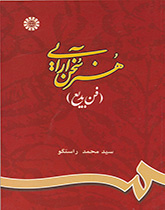
The Art of Rhetorics
From among the teachings and knowledge of literature, none attains the importance of semantics, eloquence and rhetoric, the three branches of rhetorics. The importance of these three branches of knowledge is so much that without mastering them, neither the rhetoricians nor literary scholars can produce worthy literary-artistic works or analyze and critique the language and find its tortuous movements and expose them; nor can discourse analysts decode its mysteries and ambiguities to feel elation.
In this book rhetoric is studied form a new perspective. In classifying and labeling literary figures and in describing them, a new method is utilized. Concerning this fact attempts has been made so that its relation with traditional rhetoric is maintained, and the reader is familiarized with traditional rhetorical expressions along with the modern idiom.
This book tries: to present literary figures logically and classify related terms in one group; to extend clear findings by bringing attractive and expressive examples at the beginning of each part and section with their explanations; to inform the reader even further, after discussing each figure, supplementary points and remarks are added; many of the examples are chosen from contemporary speakers to show that contrary to the dominant belief in the decrepitude, impracticality and death of rhetoric and eloquence, they are still thriving in the compositions of present-day poets.
The book is in nineteen chapters. In these chapters alliteration; epigrams; word plays; clause setting; playing with hemistich; working with poetic lines; stanza; structure; choral songs; poetic traps; ....; excusing techniques; proverbs; the Quranic verses in poetry; Hadith in poetry; purple patches; poetic reiterations; redundancy; and some other figures like invention; Socratic wisdom; spiritualism; aesthetics of fancy; aesthetics of the opening; aesthetics of the ending; poetic entertainment; and lingual games are studied.
There are graphs in the book. There is also a part for more practice, glossary, catalog of traditional rhetoric and an index at the back of the book.
Compiled for the students of Persian language and literature as a textbook for the course “Rhetoric”, this book studies rhetoric from a new perspective; in classifying and labeling literary figures and in describing them, a new method is utilized.




